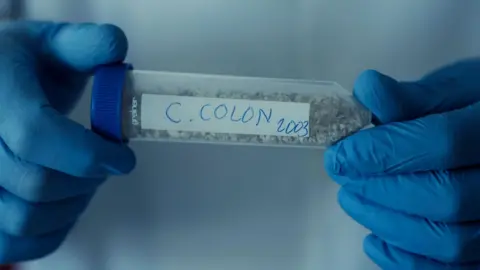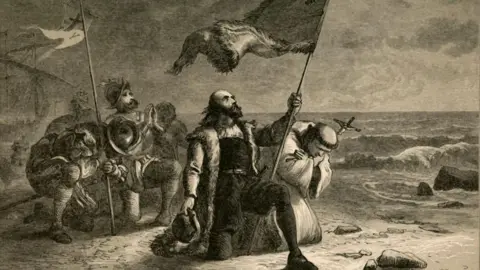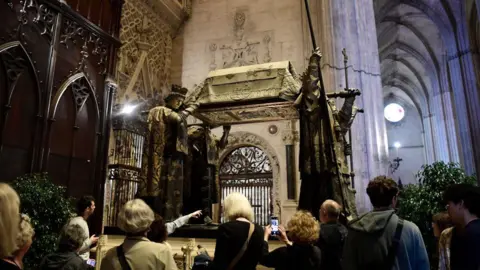 RTVEDNA samples were taken in 2003 from the bones of Columbus – known in Spanish as Cristóbal Colón – and his son HernandoMore than five centuries after he re-shaped history by opening up the New World to European exploration, scientists say they are ready to reveal the truth about the origins of Christopher Columbus.
RTVEDNA samples were taken in 2003 from the bones of Columbus – known in Spanish as Cristóbal Colón – and his son HernandoMore than five centuries after he re-shaped history by opening up the New World to European exploration, scientists say they are ready to reveal the truth about the origins of Christopher Columbus.
The explorer reached the Americas in 1492 with the support of the Spanish Crown.
But although mainstream history books describe him as a native of Genoa, uncertainty has surrounded his provenance and many countries and regions have claimed him as their own.
Now, after more than two decades of research, scientists say they have enough evidence to solve the argument over the birthplace of Columbus.
In 2003, José Antonio Lorente, professor of forensic medicine at Granada University, and the historian Marcial Castro, exhumed what were believed to the remains of Columbus from Seville cathedral to take DNA samples. They also took DNA from the bones of his son, Hernando, and brother, Diego.
Since then they have compared the DNA with that of historical figures from different countries and regions in order to solve the mystery, using technological advances to ensure the veracity of the results.
 Getty ImagesColumbus and his expedition made landfall in 1492The answer is expected to be revealed in a documentary film due to be shown by Spain’s national broadcaster RTVE on Saturday, which is a national holiday marking Columbus’s arrival in the Americas.
Getty ImagesColumbus and his expedition made landfall in 1492The answer is expected to be revealed in a documentary film due to be shown by Spain’s national broadcaster RTVE on Saturday, which is a national holiday marking Columbus’s arrival in the Americas.
Ahead of the broadcast of the film, billed as “a documentary thriller”, the forensic team has revealed one result of its research: that the remains exhumed from Seville were indeed those of the explorer.
The Dominican Republic has long claimed that it is host to his body and a mausoleum is dedicated to him in the city of Santo Domingo.
In presenting this finding, Prof Lorente said that “we have been able to prove beyond all doubt, with new technology, the previously unconfirmed theory that the remains in Seville are those of Christopher Columbus”.
However, the team has said it is possible that some remains of the explorer are in the Dominican Republic, which did not co-operate with the project.
But Columbus’s birthplace is the biggest enigma.
 Getty ImagesResearchers say they have definitively confirmed that the bones buried in Seville's cathedral belong to Christopher ColumbusThe widely accepted theory is that he was born in Genoa, in 1451, to a family of wool weavers.
Getty ImagesResearchers say they have definitively confirmed that the bones buried in Seville's cathedral belong to Christopher ColumbusThe widely accepted theory is that he was born in Genoa, in 1451, to a family of wool weavers.
In 1492, he led an expedition backed by Spain’s Catholic Monarchs seeking to establish a new route to the Far East.
Instead, he reached the Caribbean, marking the beginning of a period of European contact with the Americas which would lead to conquest and settlement – and the deaths of many millions of indigenous people due to diseases and war.
It is widely accepted that Columbus died in 1506 in the northern Spanish city of Valladolid.
There have been an estimated 25 or so separate claims regarding where he was born, including from Poland, Scotland, Hungary and Scandinavia.
However, Prof Lorente’s team whittled the candidates down to eight possible birthplaces, in Spain, Portugal and Italy. The process has involved comparing Columbus’s DNA with that of individuals believed to be his relatives in these locations.

About the author